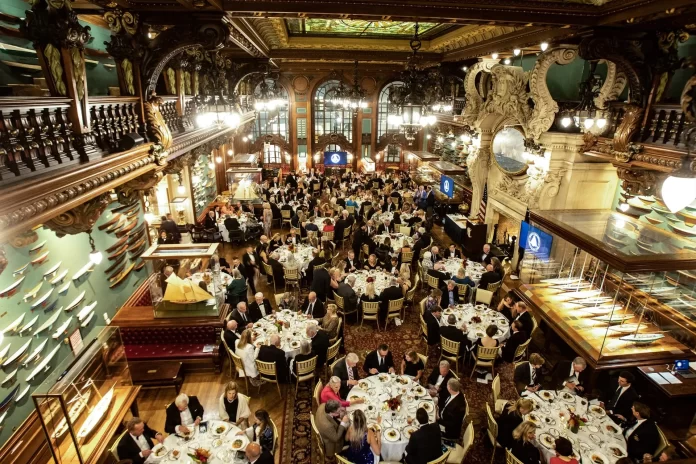In the New York Yacht Club’s iconic Model Room, the Herreshoff Marine Museum/America’s Cup Hall of Fame welcomed James Spithill, Paul Cayard, and Susan Henn as Class of 2025 inductees of the America’s Cup Hall of Fame on October 16th, 2025. Presenting Sponsor L’Oréal also celebrated the 30th anniversary of their sponsorship of the America3 women’s team which almost won the 1995 Defender Trials.
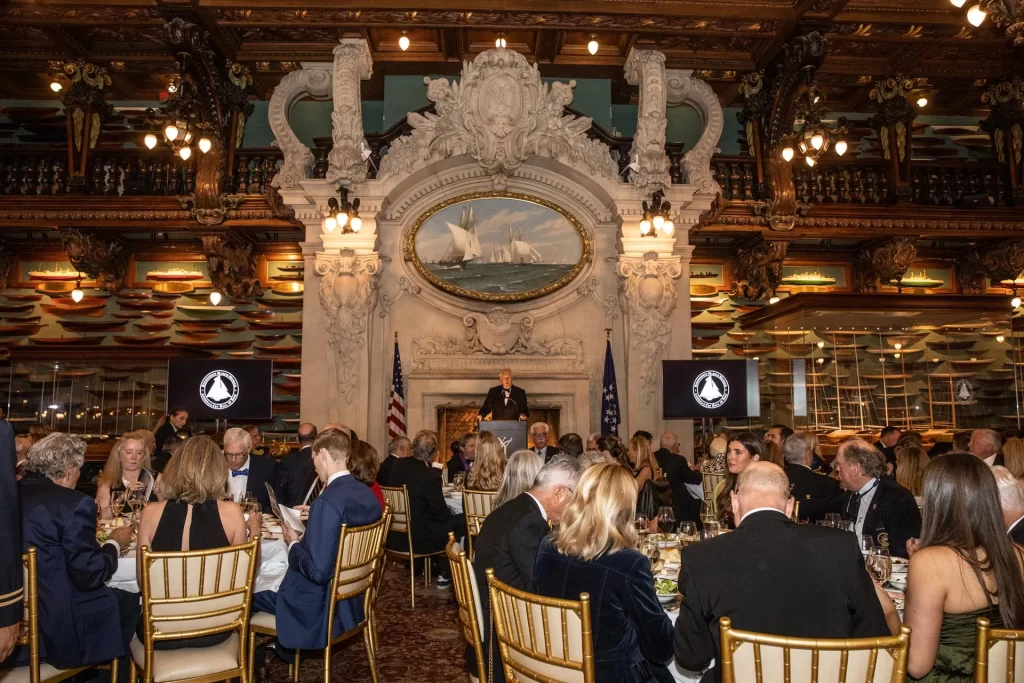
“The Class of 2025 includes some of the most accomplished and well-known sailors of the 21st Century, and the first woman to compete for the Cup,” said America’s Cup Hall of Fame Selection Committee Chair Steve Tsuchiya. “It was an electric evening, and a thrill to celebrate with the inductees, their friends, and families. The speeches by the inductees, as well as those by Henry Foster (great-great-great grandnephew of the husband of Susan Henn) and Dawn Riley, who spoke on behalf of Henn, were among the best ever delivered at an America’s Cup Hall of Fame event!”
“The energy of the sellout audience celebrating the induction of Cayard, Spithill, and Henn was off the charts,” said Emcee Gary Jobson, who has attended over 400 events in the Model Room. “I’ve never seen the Model Room of the New York Yacht Club so vibrant.”
The America’s Cup Hall of Fame has inducted over one hundred individuals since its founding in 1992. Candidates eligible for consideration include sailing team members, designers, builders, syndicate leaders, supporters, chroniclers, and other individuals of merit. Each nominee is judged on the basis of outstanding ability, international recognition, character, performance, and contributions to the America’s Cup. The members of the Selection Committee are intimate with the history and traditions of America’s Cup and are committed to maintaining the integrity of the Hall of Fame.
“This induction was truly special – not an empty seat in the house!” said America’s Cup Hall of Fame President & Executive Director Bill Lynn. “We were treated to stirring acceptance speeches, and Emcee Gary Jobson not only brought his “A game” but also fabulous video tributes to the inductees!”
America’s Cup Hall of Fame Inductees, Class of 2025
James “Jimmy” Spithill (AUS) (b. 1979)
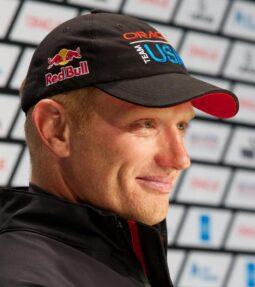
In 2000, Australian James “Jimmy” Spithill cemented his place in America’s Cup history when, at just 20 years old, he became the competition’s youngest helmsman and skipper. In 2013, he achieved something even more remarkable: winning the 34th Match from a -2 starting deficit to a 9-8 victory. The Wall Street Journal described ORACLE Team USA’s incredible, against-the-odds victory over Emirates Team New Zealand as one of the most extraordinary comebacks in any sport. Jimmy Spithill exemplifies what it means to be an “Aussie battler”—a person who demonstrates perseverance to overcome a disadvantage.
Born on June 18, 1979, in Sydney, one of Spithill’s earliest memories is the jubilation that swept across his home country when AUSTRALIA II won the 1983 America’s Cup, especially in the Pittwater area where crew members Colin Beashel and Rob Brown lived.
Spithill’s family had moved north from Sydney to the Pittwater area and lived near Scotland Island in Elvina Bay. “I had to go to school by boat. To get to the mainland we went by boat. It was just a way of life.” His first boat was someone else’s throwaway, recovered from a dump and made ready for racing. In 1989, Jimmy won the first race he ever entered, with his sister, but the path to his 2000 America’s Cup debut took an unconventional course.
He led his team to win the Australian High School Sailing Championship in 1997, despite having a broken wrist he had injured a day earlier while captaining the school rugby team. However, unlike many of his peers who advanced through successive dinghy classes to national or Olympic teams, Jimmy switched to match racing through a youth program at the Royal Prince Alfred YC. This program recognized talent regardless of background or identity and allowed kids to sail who didn’t own a boat.
Keeping a beady eye on Spithill’s progress was one of Australia’s greatest ocean racers and a previous America’s Cup challenger, Syd Fischer. He invited Spithill aboard his 50-footer RAGAMUFFIN in 1998 for a third-boat-to-finish in the storm-ravaged Sydney-Hobart Race. Spithill placed sixth in his first Grade 1 Match Race Tour event the following year and became Fischer’s pick for the skipper of Young Australia for the 2000 America’s Cup in Auckland.
A defining moment in James Spithill’s career, it also marked a significant chapter in the history of the America’s Cup. At just 20 years old, he became its youngest-ever helmsman and skipper. Young Australia was characterized by a limited budget and ambitious dreams, using Fischer’s boat from the previous America’s Cup, SYDNEY ’95, which had finished last in San Diego. Despite being the only team racing a previous-generation boat, Spithill and his fellow crew of eager and aspiring youngsters bested the Swiss entry helmed by German legend Jochen Schümann in the overall standings.
Jimmy Spithill was far from the only one to have his America’s Cup career launched by Fisher’s 2000 campaign. However, few took full advantage of their opportunities as Spithill did, as he was consistently in demand by top teams throughout his career. He was involved with the American OneWorld and ORACLE Team USA teams, as well as Luna Rossa from Italy. He won the 33rd America’s Cup match in 2010 with ORACLE Team USA, defeating Alinghi (Switzerland). And, in 2013, he successfully defended the Cup with ORACLE Team USA in the 34th Match against Emirates Team New Zealand.
In these two matches, Jimmy Spithill left two lasting marks on America’s Cup history. By helming the 113ft (34m) trimaran USA 17 in the 2010 match, he expanded his skills beyond slow, heavy displacement monohulls to master high-speed sailing on a giant multihull powered by the tallest single-span wing ever built at 223ft (68m), twice the length of each wing of a Boeing 747. America’s Cup yachts achieved speeds never seen before.
In the 2013 Match, ORACLE Team USA started with a -2 score after the International Jury penalized the team for an earlier rules breach in another class. The New Zealanders quickly advanced to match point with an 8-to-1 lead, partly because they were the first to perfect gybing while foiling. But Spithill famously declared, “It’s a long way from being over.” He and his team improved their boat handling, and the team’s engineers made adjustments to the boat. Then they went on to win every race in the series, completing the most incredible comeback in America’s Cup history. He reflected on the 9-8 victory, “That’s the great thing about sport and in life, that, you know, if it’s not over, if they haven’t handed the trophy over, you still have a shot.”
After the 2024 America’s Cup in Barcelona, where he co-skippered the Italian Luna Rossa Prada Pirelli team, Spithill brought 25 years of consecutive helming to a close. This period witnessed the most remarkable transformation of America’s Cup boats, from the ACC 80-ft displacement monohulls in 2000, 2003, and 2007 to the impressive and extreme USA 17 trimaran in 2010, and the AC72 and AC50 foiling wing sail catamarans in 2013 and 2017, up to the AC75 foiling monohulls in 2021 and 2024. Throughout, Spithill reinforced his reputation as one of the toughest opponents his peers could ever face. “I’m not an aggressive person, but obviously on the sporting field, I’ll do whatever it takes. I just love sports. I love competing. I’m obsessed by it, to be honest, I love being in a team working with people better than me.”
Paul Cayard (USA) (b. 1959)
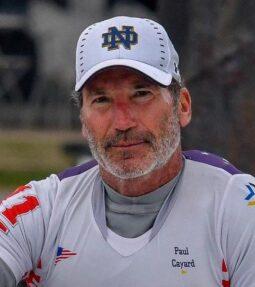
Paul Cayard began his sailing career by winning in a tiny El Toro dinghy at the age of eight. Years later, he remarked, “As an eight-year-old, sailing just bit me. I really liked it. As a kid you’re always doing what your parents tell you. But when I was on my boat, I was the captain of my ship. I was in charge of my own destiny.”
One word that defines Cayard’s remarkable career is “versatile.” He has won eight World Championships and the Whitbread Round the World Race, and competed in seven America’s Cup campaigns. In addition to his racing experience, he became one of the most effective communicators of the joys and challenges of grand prix yacht racing.
Rounding out those accomplishments are some notable complementary skills. Due to his European family roots, Cayard is fluent in English, French, and Italian; he is a licensed pilot and has demonstrated effectiveness as a marketer and manager. He learned about business practices from many of the titans of industry with whom he raced over the years. In the process, Cayard became a strong leader and a vital asset in running an America’s Cup campaign.
Cayard was first recruited for the Cup by the late Tom Blackaller to serve as a sail trimmer aboard the 12-Meter DEFENDER in 1983. The boat had below-average speed and was eliminated early during the defense trials. Despite this disappointing showing, Cayard was smitten and jumped at the opportunity to try again. His next campaign would be as tactician for Blackaller in the 1987 America’s Cup in Fremantle, Australia. Their innovative boat featured a forward canard rudder, a bulbous keel, and a traditional rudder at the stern. At times, they demonstrated remarkable speed, advancing to the semi-final round. After two America’s Cups serving as crew for Blackaller, Cayard decided to go his own way.
In 1988, Cayard won his first International Star Class World Championship. With that prestigious victory, he gained significant international recognition. Italian business mogul Raul Gardini recruited Cayard to skipper his maxi yacht, IL MORO DI VENEZIA. That same year, they won the Maxi Yacht World Championship. Cayard encouraged Gardini to compete in the 1992 America’s Cup. For Cayard, it meant joining an Italian team. He spoke Italian and felt right at home with the crew. Gardini and Cayard won the Louis Vuitton Cup Challenger series but lost to AMERICA3 in the America’s Cup match, 4-1.
In 1995, he served as helmsman for Dennis Conner’s America’s Cup defense campaign. They reached the Cup match but lost 5-0 to Team New Zealand, which had developed an exceptionally faster boat. The Royal New Zealand Yacht Squadron scheduled the next match for 2000.
It was a long wait, but Cayard used the time to achieve a notable victory. He was chosen to captain EF LANGUAGE in the 1997-98 Whitbread Round the World Race. Although Cayard had competed in some long-distance races, he had never faced anything as demanding or exhausting as the Whitbread. The race organizers allowed sailors to communicate with fans during the long ocean legs, a first in ocean racing history. Cayard wrote compelling accounts of battling squalls while racing around the Southern Ocean or drifting endlessly through the doldrums near the equator. EF LANGUAGE ultimately won the Whitbread, and Cayard was recognized as a small boat sailor who mastered long-distance racing.
With the momentum and confidence gained from winning the Whitbread, Cayard launched a campaign for the 2000 America’s Cup in New Zealand. This time, Cayard challenged on behalf of his home club, the St. Francis Yacht Club. His team, AmericaOne, reached the Louis Vuitton Cup final against the Prada Challenge from Italy.
In the best-of-nine series for the Louis Vuitton Cup, with the score tied at 4-4, the final race was quite a show for everyone, with the lead changing hands multiple times during the race. Cayard came up short, losing the 18.5-mile, six-leg race by 47 seconds. For many, such a tough defeat might spell the end of the line, but Cayard had greater ambitions.
After focusing on Grand Prix racing, he started a new role as a leader committed to giving back to the sport. Cayard served as board chair of the St. Francis Yacht Club from 2018 to 2020. In 2024, Cayard was elected President of the International Star Class Association. In September this year, Cayard, at age 66, won his second Star World Championship title in Split, Croatia, with his crew Frithjof Kleen. This historic victory came 37 years after Cayard’s first Star World Championship win.
With a lifetime of experience, Paul Cayard understands what it takes to prevail at the highest levels of sailing. “Sailing, like all sports, is extremely competitive and there are a lot of young, hungry sailors who would love to be sailing in the America’s Cup or the Olympic Games,” he said. “It takes nothing short of total dedication. Boats are much more athletic now. I’ve always considered myself athletic. It was bred in me, not from sailing, but from playing football and basketball in high school, and I’ve always stayed in great shape. Where sailing is right now, if you are young and you want to be at the top of this game, you might as well adopt the 100-meter sprinter’s training regime.” Paul Cayard is the epitome of what a top athlete is all about. It’s a proven formula: keep reaching high, learn from your mistakes, and move on to the next adventure.
Susan Henn (SCO) (1853-1911)
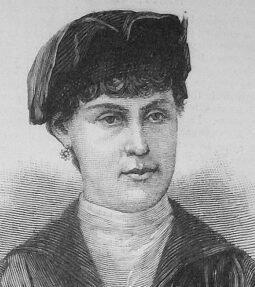
Susan Matilda Cunninghame-Graham Bartholomew Henn is celebrated as the first woman to compete in the America’s Cup. Henn sailed on the 102-ft (31m) steel cutter, GALATEA, which she also commissioned, financed, and commanded during part of the 1886 match against General Charles J. Paine’s MAYFLOWER.
Born in Rothesay on the Isle of Bute, Scotland, Susan was the daughter of Susan Jane Cunninghame-Graham, from an aristocratic Scottish family, and Robert Bartholomew, a scion of a wealthy cotton family from Glasgow. She grew up in a family of sailors who raced their yachts in the Firth of Clyde, where she developed her sailing skills.
In 1877, while sailing in the Mediterranean with her younger brother Robert, Susan met and married Lt. William Henn RN from County Clare, Ireland, a retired Royal Navy officer who was then racing and cruising his yacht. Their union set her on a course for a permanent life at sea, likely giving Susan more sea time experience than perhaps any other America’s Cup sailor.
Following her brother’s death, Susan used a significant inheritance to commission yacht designer J. Beavor-Webb to design GALATEA, the first all-steel yacht to challenge for the America’s Cup. GALATEA was originally intended to compete in 1885 in a double Cup match alongside Sir Richard Sutton’s GENESTA. However, delays in GALATEA’s construction affecting her keel caused her to challenge the following year in 1886, facing MAYFLOWER, a design one generation newer than GALATEA. GALATEA’s design, like that of GENESTA, reflected the leading British yacht technology of the time, favoring cutters with long, deep, narrow hulls and a trans-Atlantic reputation for speed.
Instead of taking a faster and far more comfortable journey by steamship, Susan sailed on GALATEA across the Atlantic for the match. Although they lost both races in the Cup match, Susan demonstrated exceptional skill when she took charge of the yacht after her husband’s health declined during the competition, and he became incapacitated. This made her not only the first woman to compete in but also the first woman to command a yacht in an America’s Cup match.
She earned respect in New York, with reports highlighting her enthusiasm and capabilities: “Owning to severe indisposition, Lt. Henn was to take hardly any part in the contests, but Mrs Henn engaged in the events with all the enthusiasm and skill of a masterful helmswoman.”
Her achievements were particularly groundbreaking, considering the social and legal restrictions placed on married women in Victorian society. They often faced barriers to joining yacht clubs and participating in the sport, despite some being skilled and experienced sailors.
After their America’s Cup match, Susan and Lt. Henn explored American waters, awaiting a new Cup challenge from their Clyde-based friends and colleagues with their new G.L. Watson-designed THISTLE during the following season. They later returned to British and Mediterranean waters to continue cruising and occasionally racing in GALATEA.
In 1890, a reporter reflected on Susan’s life at sea: “Mrs. Henn is undoubtedly the most finished and competent yachtswoman in the world. She makes her home on board the yacht for nine months in the year, and during the other three she pines for a return. One of her common expressions is that she never gets rid of her sea-legs, and she avows that she cannot dance anywhere but on the deck of a ship.”
Susan, true to her words, remained aboard GALATEA after Lt. Henn’s death in 1894 until her own passing in 1911. Without children, she left her estate to her cousin, the notable Scots adventurer, author, and politician Robert Bontine Cunninghame-Graham.
Susan Henn is buried in Rothesay, Scotland, where she was born. The America’s Cup Hall of Fame honors her as a pioneering and inspiring figure in sailing and an important part of the Cup’s storied history.
America’s Cup Hall of Fame Selection Committee
- R. Steven Tsuchiya, Chairman
- Margherita Bottini
- John S. Burnham
- Brad Butterworth
- William Collier
- Richard Gladwell
- Jack Griffin
- Halsey C. Herreshoff
- Tim Jeffery
- Gary Jobson
- Andrew Johns
- Murray Jones
- William H. Dyer Jones
- John Lammerts van Bueren
- Ken McAlpine
- Elizabeth E. Meyer
- Shirley Robertson
- Blue Robinson
- Hamish Ross
- Mike Toppa
- Bruno Troublé
- Tom Whidden
About the Herreshoff Marine Museum & the America’s Cup Hall of Fame
The Herreshoff Marine Museum, located in Bristol, Rhode Island, USA, is a maritime museum dedicated to the history of the Herreshoff Manufacturing Company and the America’s Cup. The Herreshoff Manufacturing Company (1878-1945) was most notable for producing fast sailing yachts, including eight America’s Cup defenders, and steam-powered vessels. The museum, situated near Narragansett Bay on the grounds where the manufacturing company once stood, has a collection of over sixty boats including Nathanael Greene Herreshoff’s CLARA, built in 1887, Harold Vanderbilt’s TRIVIA, and the 1992 ACC yacht DEFIANT.
The America’s Cup Hall of Fame was founded in 1992 to preserve the legacy and history of the America’s Cup competition, celebrating its heroes and inspiring future generations of Cup enthusiasts and participants by connecting the past with the present – and the future. It does this in part by maintaining a comprehensive collection of AC artifacts and ephemera, as well as a collection of photography and video, and by celebrating everything that makes the America’s Cup one of the world’s most compelling sporting events.




